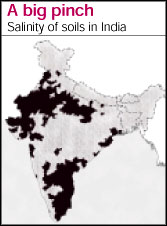More and more water
 A third factor has led to the current debility of soils in India: irrigation. That is to say, water over-use. To feed the rice-wheat mentality, net irrigated area rose from 20.8 million ha in 1950 to 53.5 million ha in 1995-1996. Fed on irrigation, the agricultural area grew from a mere 20.8 per cent in 1966-1967 to 42.4 per cent of the 120 million ha of cultivated land in the country by 1997-1998. Canals began to weave their way through the land, bringing subsidised water right up to the farm-gate. Farmers went on a flood; then began to suffer.
A third factor has led to the current debility of soils in India: irrigation. That is to say, water over-use. To feed the rice-wheat mentality, net irrigated area rose from 20.8 million ha in 1950 to 53.5 million ha in 1995-1996. Fed on irrigation, the agricultural area grew from a mere 20.8 per cent in 1966-1967 to 42.4 per cent of the 120 million ha of cultivated land in the country by 1997-1998. Canals began to weave their way through the land, bringing subsidised water right up to the farm-gate. Farmers went on a flood; then began to suffer.
Take the case of Ram Pal, of village Kalwala in Bhatinda district, south Punjab. He has a family of three to feed and aRs 50,000 debt. His only asset
Related Content
- World health statistics 2025: Monitoring health for the SDGs, Sustainable Development Goals
- Order of the National Green Tribunal regarding illegal extraction of groundwater in Manakpura, Delhi by the water mafia, 13/05/2025
- Order of the National Green Tribunal regarding state of groundwater in Haryana, 23/01/2025
- Order of the National Green Tribunal regarding constructions on Yamuna floodplains, 21/01/2025
- Reducing post-harvest losses in Indian agriculture: a case study of selected crops
- Compliance report by Andhra Pradesh on the presence of arsenic and fluoride in the groundwater of the state, 29/03/2024
